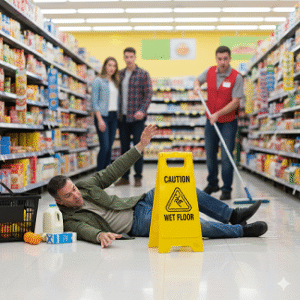Quick Takeaways / Key Points
Slip and Fall Accidents: Over 8 million hospital visits annually; common in public and private properties.
Common Causes: Wet floors, uneven surfaces, poor lighting, clutter, weather hazards, defective stairs.
Impact on Victims: Physical injuries, emotional distress, financial loss, and social consequences.
Common Mistakes: Not reporting, failing to document, admitting fault, posting online, accepting low settlements.
Liability Factors: Duty of care, breach, causation, and comparative negligence laws.
Insurance Tactics: Denials, delays, lowball offers, surveillance.
Legal Strategies: Timely reporting, documentation, hiring specialized attorneys, and pursuing full damages.
Understanding Slip and Fall Accidents: Causes, Liability, and Compensation
Slip and fall accidents are a leading cause of injuries in the United States, resulting in millions of emergency room visits annually. These incidents, classified under premises liability law, occur when someone is injured due to hazardous conditions on another’s property. They can happen anywhere—grocery stores, workplaces, private homes, or public sidewalks—and often lead to significant physical, emotional, and financial consequences for victims. According to the National Floor Safety Institute, falls account for over 8 million hospital visits each year, with slip and falls being the primary cause of workers’ compensation claims and a major source of personal injury lawsuits.
This article provides a comprehensive look at slip and fall accidents, exploring their common causes, the impact on victims, typical mistakes made by claimants, how liability is determined, the role of insurance companies, prevalent misconceptions, and strategies for securing fair compensation. Whether you’re a victim or seeking to understand your legal rights, this guide will equip you with the knowledge to navigate these complex cases.
Common Causes of Slip and Fall Accidents
Slip and fall accidents stem from hazardous conditions that property owners or managers fail to address. Below are the most frequent causes, based on legal cases and safety data.
1. Wet or Slippery Surfaces
Spills, leaks, or recently cleaned floors without warning signs (e.g., “Wet Floor”) are common culprits. Examples include a grocery store aisle with spilled juice or a restaurant with a freshly mopped floor.
Impact on Victims: These falls often result in sprains, fractures, or head injuries. Elderly victims may suffer hip fractures, requiring surgery and long-term rehabilitation. The emotional toll includes fear of falling again, while financial burdens cover medical bills and lost wages.
2. Uneven or Damaged Surfaces
Cracked sidewalks, uneven flooring, or loose tiles in buildings can cause trips or stumbles. For instance, a poorly maintained parking lot with potholes poses significant risks.
Impact on Victims: Injuries like ankle sprains, knee damage, or wrist fractures are common. Severe cases may lead to chronic pain or mobility issues, causing emotional distress and financial strain from ongoing treatment and reduced earning capacity.
3. Inadequate Lighting
Poorly lit stairwells, parking garages, or walkways make it hard to spot hazards, increasing fall risks. A dimly lit apartment complex staircase is a classic example.
Impact on Victims: Falls in low-light conditions often cause head trauma, concussions, or broken bones. Victims may develop anxiety about navigating public spaces, with medical costs and lost productivity adding financial pressure.
4. Clutter or Obstructions
Objects left in walkways, such as cables, merchandise, or debris, can cause trips. Retail stores with cluttered aisles or construction sites with scattered materials are frequent settings.
Impact on Victims: Resulting injuries include bruises, dislocations, or soft tissue damage. Victims may face prolonged recovery, emotional frustration, and financial losses from therapy and time off work.
5. Weather-Related Hazards
Ice, snow, or rain on walkways, especially without proper maintenance like salting or clearing, often leads to falls. This is common in regions with harsh winters.
Impact on Victims: Injuries range from minor slips to severe fractures or spinal injuries. The elderly are particularly vulnerable, facing long-term mobility issues. Emotional and financial impacts include isolation and costs for medical care and adaptive equipment.
6. Defective Stairs or Handrails
Broken steps, missing handrails, or uneven stair heights in buildings can cause falls. For example, a wobbly handrail in an office building increases risk.
Impact on Victims: Falls on stairs often result in serious injuries like spinal damage or traumatic brain injuries (TBIs). Victims endure physical pain, emotional trauma, and financial hits from extended recovery and potential disability.
Injured in a slip and fall accident? Don’t let insurers minimize your claim. Contact Edvin Jones Injury Law for a free, fast, and professional case review to protect your rights and maximize your compensation.
Impact of Slip and Fall Accidents on Victims
Slip and fall accidents have far-reaching consequences:
- Physical: Injuries include fractures (e.g., hip, wrist), sprains, concussions, or spinal injuries. Severe cases lead to permanent disabilities or chronic pain, requiring surgeries or long-term therapy. For example, a hip fracture may cost $50,000-$100,000 in medical care.
- Emotional: Victims often experience fear of falling, anxiety, or depression, particularly if mobility is limited. Social isolation can occur, especially for seniors, impacting mental health.
- Financial: Medical expenses, rehabilitation costs, and lost wages can be substantial. A victim missing six months of work may lose $20,000-$50,000 in income, depending on their profession.
- Social and Familial: Reduced mobility affects daily activities, caregiving roles, or social engagements, straining relationships and causing emotional distress.
 Common Mistakes People Make in Slip and Fall Cases
Common Mistakes People Make in Slip and Fall Cases
Victims often jeopardize their claims through avoidable errors:
- Not Seeking Immediate Medical Care: Delaying treatment allows insurers to argue injuries aren’t serious or unrelated to the fall.
- Failing to Report the Incident: Not notifying the property owner or manager immediately weakens the case, as no official record is created.
- Not Documenting the Scene: Failing to take photos of the hazard (e.g., a spill) or collect witness contact information reduces evidence.
- Admitting Fault: Saying “I should’ve watched where I was going” can be used against you, even if the property owner was negligent.
- Posting on Social Media: Sharing posts that suggest you’re uninjured (e.g., exercising) can discredit your claim.
- Accepting Quick Settlements: Early insurance offers often undervalue long-term damages like future medical needs.
- Not Consulting an Attorney: Handling claims alone risks missing legal nuances or deadlines, reducing compensation.
Determining Liability in Slip and Fall Cases
Liability hinges on proving negligence, meaning the property owner failed to maintain safe conditions. Key factors include:
- Duty of Care: Owners must keep properties safe for visitors (e.g., customers, tenants). The level of care varies by visitor type—invitees (e.g., shoppers) are owed the highest duty, while trespassers receive minimal protection.
- Breach of Duty: Evidence must show the owner knew or should have known about the hazard (e.g., a spill ignored for hours) and failed to fix it.
- Causation and Damages: The hazard must directly cause the injury, resulting in measurable losses like medical bills or pain and suffering.
- Comparative Negligence: In some states, if the victim was partially at fault (e.g., distracted walking), compensation may be reduced proportionally.
For example, if a store ignored a known spill for hours, they’re likely liable. But if the victim was texting and didn’t notice a warning sign, their award might be reduced under comparative negligence laws.
How Insurance Companies Treat Victims in These Cases
Insurance companies, representing property owners, aim to minimize payouts using aggressive tactics:
- Denying Liability: They may claim the hazard was “open and obvious” or the victim was at fault.
- Lowball Offers: Initial settlements often cover only immediate costs, ignoring long-term damages like chronic pain or lost income.
- Delaying Claims: Insurers may stall investigations, hoping victims accept less out of financial desperation.
- Requesting Excessive Evidence: Demanding repetitive documentation can frustrate victims into abandoning claims.
- Surveillance and Social Media Scrutiny: Insurers may monitor victims’ online activity or hire investigators to dispute injury severity.
Victims without legal representation are especially susceptible to these strategies, often receiving far less than deserved.
Common Misconceptions in Slip and Fall Cases
Several myths can mislead victims:
- All Falls Lead to Lawsuits: Not true—negligence must be proven; minor incidents without fault don’t qualify.
- Property Owners Are Always Liable: Owners aren’t responsible if the hazard was unavoidable or the victim was reckless.
- Claims Are Quick and Easy: Cases can take months or years, requiring extensive evidence and negotiation.
- You Can Sue Anytime: Statutes of limitations (typically 2-3 years, varying by state) restrict filing periods.
- Insurance Covers Everything: Policies may not fully cover non-economic damages like pain and suffering, requiring legal action.
- DIY Claims Are Sufficient: Self-representation often leads to undervalued settlements due to complex liability rules.
Solutions to Achieve Fair Compensation
To secure favorable outcomes in slip and fall cases:
- Act Promptly: Report the incident to the property owner and seek medical care immediately to establish a record.
- Document Thoroughly: Take photos of the hazard, injuries, and scene. Collect witness statements and keep medical records, bills, and receipts.
- Hire a Specialized Attorney: A premises liability lawyer can prove negligence, negotiate with insurers, and handle legal deadlines, typically on a contingency basis (no fees unless you win).
- Avoid Insurer Traps: Let your attorney manage communications to prevent statements being used against you.
- Pursue All Damages: Include economic damages (medical costs, lost wages) and non-economic damages (pain, suffering), using experts to project future losses.
- Consider Mediation: Alternative dispute resolution can resolve cases faster, avoiding trial risks.
- Be Patient and Persistent: Strong evidence and legal support lead to better settlements or verdicts, even if the process is lengthy.
For example, a victim who documents a fall caused by an unmarked spill, seeks immediate medical care, and hires an attorney might secure a $200,000 settlement, covering $80,000 in medical bills, $50,000 in lost wages, and $70,000 for pain and suffering, far surpassing an initial
Slip and fall accidents are a major source of personal injury claims in the U.S., often caused by property owner negligence. This guide covers their common causes, liability rules, insurance tactics, and strategies to secure fair compensation. Victims who act quickly and hire skilled attorneys stand the best chance of maximizing their recovery.
❓ 5 FAQs with Answers
1. What should I do immediately after a slip and fall accident?
Report the incident, document the scene with photos, get medical care, and contact a personal injury lawyer as soon as possible.
2. Who can be held liable for a slip and fall?
Property owners, managers, or maintenance companies may be held responsible if they failed to fix or warn about hazards.
3. How long do I have to file a slip and fall claim?
Most states have a statute of limitations of 2–3 years, but it’s best to consult an attorney promptly to avoid missing deadlines.
4. Do I need a lawyer for a slip and fall case?
Yes. An experienced premises liability lawyer can help prove negligence, deal with insurance companies, and maximize your settlement.
5. What types of compensation can I recover?
You may recover medical expenses, lost wages, pain and suffering, rehabilitation costs, and future care expenses.

 Common Mistakes People Make in Slip and Fall Cases
Common Mistakes People Make in Slip and Fall Cases